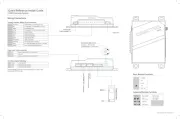Gemini 5002 Handleiding
Gemini
Auto alarm
5002
Bekijk gratis de handleiding van Gemini 5002 (8 pagina’s), behorend tot de categorie Auto alarm. Deze gids werd als nuttig beoordeeld door 16 mensen en kreeg gemiddeld 5.0 sterren uit 8.5 reviews. Heb je een vraag over Gemini 5002 of wil je andere gebruikers van dit product iets vragen? Stel een vraag
Pagina 1/8

5002/3 INSTALLATION INSTRUCTIONS
The Gemini 5002 and 5003 are remote controlled alarm units with built-in central
door locking adapters, ultrasonic and total closure facility for selected vehicles.
The 5002 and 5003 are complete with cryptographic coded transmitters complete
with Gemini Card which has an alphanumeric code printed on it to enable you to get
a replacement at any time. The units offer panic facility. The system also includes
passive arming and provides outlets for supplementary sirens and the vehicle hazard
lights circuit. There is also the optional audible signalling for arming and disarming.
(The 5003 incorporates its own internal battery).
The alarms offer the following protections:
• The passenger compartment via pin switches and voltage drop sensing (can be
isolated).
• Boot and bonnet by pin switches.
• Radio cassette and other accessories by "Accessory Loop" (can be isolated)
• The engine immobilisation is obtained by the interruption of starter crank wire at
the back of the ignition switch.
The alarms also have the following abilities:
• The control of additional sirens and negatively controlled horns.
• Can be connected to microwave, vibration and anti-lifting sensors.
• Can be connected to window closures and sunroof closures providing this
operation DOES work off the drivers door key.
• The sensors can be isolated through the transmitter via R.S.D. function.
•• A.C.R. Function (Automatic Current Reduction). For activation periods of 48
hours or more the unit will automatically switch off flashings LED and additional
modules. This will save on current drain from the battery. If any attempted break-
in occurs the alarm will trigger instantly.
•• STATUS L.E.D. If the unit has been triggered, on disarming the system the LED
will fash in a certain sequence to indicate which circuit has been violated.
PRE-INSTALLATION CHECKS
Disconnect terminals of the battery and only reconnect after the installation is
complete, giving consideration to the vehicle characteristics. Set the alarm switches
as required in Table C1. The compact unit must be mounted under the bonnet, away
from areas of intense heat and direct water spray. It must be installed using supplied
bracket. The harness installation is illustrated in the diagram.
WIRING INSTRUCTIONS REF. DIAGRAM No. 1.
CABLE
COLOURS
FUNCTION OF
THE
CONNECTION
CONNECTIONS TO CARRY OUT
1
RED
Positive alarm
feed
If the voltage sensing is activated the
RED wire must be connected to the interior
light circuit in the main fuse box. If the
voltage sensing is de-activated the RED
wire can be connected to the main feed in
the fuse box or directly to the battery
positive terminal. The positive supply is
protected by a 5 Amp fuse as supplied.
2
BROWN
Negative alarm
feed
Connect the BROWN
wire to a stable body
earth using an existing body earth point or
battery negative terminal.
3
RED-
WHITE
Hazard Circuit
Power
Feed
The RED-WHITE
wire must be connected
to the main fuse feed or directly to the
battery positive terminal, using the 10 Amp.
fuse as supplied.
4
YELLOW
Ignition Live
Connect the YELLOW wire to an ignition
positive feed. This wire MUST
remain "live"
whilst starting the engine. (It is most
important to connect this wire as it will
prevent the alarm from being operated with
the ignition "on" or the engine running).
5
ORANGE
Hazard Lights Locate the left and right hand-side
indicator wires. Connect one ORANGE
wire on to each wire.
6
GREY
and
WHITE
Engine
immobilisation
This function is obtained by locating the
engine starter crank wire at the rear of the
ignition key switch. (refer to: Vehicle
Workshop Manual). Cut this wire and
connect one side to the GREY wire and the
other side to the WHITE wire. Remember to
connect the alarm YELLOW
wire (see point
4).
7
GREEN
Boot
Bonnet/Tailgate
Pin Switches
If there are no original pin switches in the
vehicle, use the switches supplied in the kit.
The connections for the pin switches are
made onto the GREEN
wire, suitably
mounted to avoid water channel and areas
of direct water spray.

8
GREEN-
BROWN
Door Pin
Switches
Connect the GREEN-BROWN wire on to
the courtesy light pin switch circuit. (If
you connect on the door pin switches, it
may be necessary to connect all the pin
switches together).
9
BLACK
Supplementary
Siren
Connect the supplementary sirens RED wire
to the bat
tery positive terminal. Connect
the alarm's BLACK wire to the
supplementary siren's BLACK
wire. If you
are not using a supplementary siren leave
the BLACK wire disconnected and insulate.
10
PINK
Positive Outlet
When
the Alarm is
Armed.
The PINK wire is a positive outlet when the
alarm is armed for use with Gemini
interface units (i.e. Gemini 2244).
11
BROWN-
BLACK
Accessory
Loop
(optional)
Connect the BROWN-BLACK wire to a
radio or fog lights negative.
If this function is not
to be used connect
this wire to a stable body earth (see table C).
12
BLACK
Aerial Leads
The BLACK
aerial lead must be located in
a non-
metallic area for best reception. It
must not be coiled or connected at the body
earth, as this would effect the system's
performance.
13. Sensing connection. Connect the volumetric, vibration and anti-lighting sensors,
colour to colour (i.e. GREEN-BLACK to GREEN-BLACK) on to the main alarm
harness. This trigger circuit will not operate more that 3 times (see Table A).
14. Ultrasonic heads. These should be mounted with brackets provided at the top of
each windscreen pillar facing the opposite corner of the vehicle. They must be
connected correctly (i.e. RED sensor lead to RED socket, WHITE sensor lead to
WHITE socket) and the leads must no be tightly coiled, cut or lengthened.
15. Status LED. Connect L.E.D. to harness as shown in diagram. The unit will give
an intermittent feed to the LED with a reduced current draw. (Refer to Table B for
sequence).
16. At this point you must check to see which type of central locking is fitted to the
car. An easy way to do this is to try and lock all doors from the passenger's door
lock. If it locks the driver's door, there is an actuator fitted. If it does not then there
is no activator in the driver's door (refer to: Diagram 3, 4, 5, 6 as required).
Ref.: Diagram No. 2
For cars already equipped with electrical central locking with an actuator in the
driver's door, and for vehicles with Gemini 2249/50 central door locking kit fitted,
(i.e. BMW, Ford).
Ref.: Diagram No. 3
For cars already equipped with electro-pneumatic central locking with an actuator
in the driver's door (i.e. Mercedes, Audi).
Ref.: Diagram No. 4
For cars already equipped with electrical central locking with an actuator in the
driver's door and where the central locking is controlled only through an existing
switch installed inside the passenger's compartment.
Ref.: Diagram No. 5
For cars already equipped with central locking without an actuator in the driver's
door a Gemini 2305 must be used, (i.e. Nissan).
Ref.: Diagram No. 6
For cars already equipped with central locking with a micro switch and not an
actuator in the driver's door, (i.e. Volkswagen, Saab) remove the existing micro
switch and fit a Gemini 2306 in its place.
FOR CARS WITH TOTAL CLOSE FACILITY
Ref.: Diagram N. 7
For BMW Series 5, 7 and 8 after 1988, where it is possible to close central
locking electric windows and sunroof and dead locking off the driver's door key.
Ref.: Diagram No. 8
For Mercedes and Audi, where it is possible to close the windows and sunroof off
the driver's door key.
Ref.: Diagram No. 9
For Vauxall (Cavalier, Carlton Calibra), Jaguar, Audi 100 with original alarm and
Porsche 928 GT 1991 onwards where it is possible to close windows and
sunroof off driver's door key (sunroof on Porsche 928 GT and Audi 100 with O.E.
alarm is possible).
Ref.: Diagram No. 10
A. Specific for Mercedes SE, SEL and SEC (W140, C140 and R129 Series),
Volvo 480 ES 1992.
B. Specific for Volkswagen all models except Polo, Passat electric sunroof.
For these connections an additional relay (Gemini 2352) must be used with a
diode on pins 85 - - positive 86 earth.
ULTRASONIC ADJUSTMENT AND TEST PROCEDURE
a. Lower one of the front windows approximately 20 cm.
b. Adjust the sensitivity fully anti-clockwise.
c. Plug L.E.D. into the back of the unit.
d. Arm the alarm and push your arm through the window. The L.E.D. will give a one
second flash when movement has been detected. If L.E.D. does not flash, turn
the sensitivity clockwise, until L.E.D. does pick up movement.
e. Finally close all windows and gently go round the vehicle tapping the windscreen
and window. If the alarm goes off you MUST reduce the sensitivity.
f. Reconnect L.E.D. into harness and fix fairlead onto siren with screws provided
(fig. D).

g. Reconnect battery to terminal. Turn the external key switch to the "ON" position.
The alarm acknowledges this operation as a disconnection and reconnection of
the vehicles battery and for this reason will arm itself, after an exit delay time of 5
seconds. On the 5003 with the external key in "ON" position the battery back up
circuits are operated, therefore, if the battery is to be disconnected for any reason
(i.e. servicing) the external key switch must be turned anti-clockwise to the "OFF"
position.
DO NOT OVERTIGHTEN HARNESS GAITER SECURING SCREWS .
PLEASE NOTE: STEAM CLEANING THIS ALARM SYSTEM WILL CAUSE
IRREPARABLE DAMAGE AND VOID ANY WARRANTY CLAIM.
TABLE A
This table illustrates the respective arming period of each entry/sensor and the
number of alarm cycles that each entry can generate.
Exit Delay
Time
Entry Sensors No. of Alarm
Cycles
40 seconds Door pin switches 3
40 seconds Bonnet/boot/tailgate switches 3
5 seconds Ignition live Unlimited
40 seconds Volumetric, vibration and anti-lifting
sensors 6
40 seconds Voltage drop sensor Unlimited
5 seconds Battery back-up sensor 5
5 seconds Accessory Loop 3
TECHNICAL DATA GEMINI 5002/3
Power supply 12 VDC
Current Draw 12 mA
Working Temperature - 30° + 85° C
Engine Immobilisation Relay Contacts 30 A
Visual Signalling Relay Contacts 20 A
Audible Tone Relay Contacts 2 A
Central Locking Relay Contacts 10 A
Immunity 50 V/m
Alarm Period 25 < > 30 sec.
Sound Level at 1 metre 122 dB
Minimum Power Absorption to Trigger 5 W
The manufacturer declines every responsibility for any possible defect or failure to the device and
to the car's electric system due to a bad installation or to the overcome of the indicated technical
features. The alarm has exclusively a dissuasive function against possible thefts.
Product specificaties
| Merk: | Gemini |
| Categorie: | Auto alarm |
| Model: | 5002 |
Heb je hulp nodig?
Als je hulp nodig hebt met Gemini 5002 stel dan hieronder een vraag en andere gebruikers zullen je antwoorden
Handleiding Auto alarm Gemini

15 Januari 2023

13 Juni 2023

12 Juni 2023

9 Juni 2023

15 Januari 2023

15 Januari 2023

7 Juni 2023

15 Januari 2023

4 Juni 2023

3 Juni 2023
Handleiding Auto alarm
Nieuwste handleidingen voor Auto alarm

27 April 2025

9 April 2025

31 Maart 2025

11 Maart 2025

30 Januari 2025

7 Februari 2024

7 Februari 2024

7 Februari 2024

6 September 2023

30 December 2022